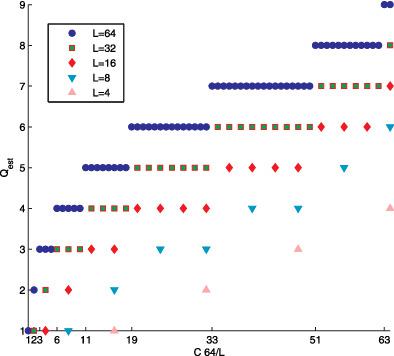当前位置:
X-MOL 学术
›
Trans. Emerg. Telecommun. Technol.
›
论文详情
Our official English website, www.x-mol.net, welcomes your
feedback! (Note: you will need to create a separate account there.)
Anticollision algorithm for radio frequency identification system with low memory requirements
Transactions on Emerging Telecommunications Technologies ( IF 2.5 ) Pub Date : 2020-04-14 , DOI: 10.1002/ett.3969 Joško Radić 1 , Petar Šolić 1 , Maja Škiljo 1
Transactions on Emerging Telecommunications Technologies ( IF 2.5 ) Pub Date : 2020-04-14 , DOI: 10.1002/ett.3969 Joško Radić 1 , Petar Šolić 1 , Maja Škiljo 1
Affiliation

|
Radio Frequency Identification (RFID) is recognized as an essential technology for the development of the Internet of Things (IoT) concept. This is due to the possibility of object identification using passive tags which do not require batteries for their operation. Instead, tags are powered by the electromagnetic waves emitted from the reader and then the same electromagnetic wave is used as a carrier to reflect the modulated information about their unique serial number back to the reader. According to the EPCglobal Class‐1 Generation‐2 RFID standard, Dynamic frame slotted ALOHA procedure is used to solve the anticollision problem. Basically, a reader adjusts the frame length for the next reading round based on the estimated number of unread tags. To achieve high reading efficiency, an algorithm with accurate estimation of the remaining number of tags is required. The article shows that for the adjustment of the next frame length, only the number of collisions is relevant. A simple estimator for the frames with 64 slots is designed, and generalized for the frames of any length provided within the EPCglobal Class‐1 Generation‐2 standard. Contrary to existing solutions, which use more tables for storage of the estimated values depending on the frame length, proposed approach requires just one table. Also, the problem of estimation is reduced to dependence on the number of collisions only, while conventional approaches use the number of collisions and successful slots.
中文翻译:

低存储需求的射频识别系统防冲突算法
射频识别(RFID)被公认为是物联网(IoT)概念发展的重要技术。这是由于使用无源标签进行对象识别的可能性,该无源标签不需要电池即可工作。取而代之的是,标签由读取器发出的电磁波供电,然后将同一电磁波用作载体,将有关其唯一序列号的已调制信息反射回读取器。根据EPCglobal Class-1第2代RFID标准,使用动态帧时隙ALOHA程序来解决防冲突问题。基本上,阅读器会根据未读标签的估计数量来调整下一轮阅读的帧长。为了达到高阅读效率,需要一种能够准确估计标签剩余数量的算法。该文章表明,对于下一帧长度的调整,仅冲突次数是相关的。设计了一个简单的估计器,用于具有64个插槽的帧,并针对EPCglobal Class-1第2代标准中提供的任何长度的帧进行了通用化。与现有解决方案相反,现有解决方案根据帧长度使用更多表来存储估计值,所提出的方法只需要一张表。而且,估计的问题减少到仅依赖于冲突的数量,而常规方法使用冲突的数量和成功的时隙。设计了一个简单的估计器,用于具有64个插槽的帧,并针对EPCglobal Class-1第2代标准中提供的任何长度的帧进行了通用化。与现有解决方案相反,现有解决方案根据帧长度使用更多表来存储估计值,所提出的方法只需要一张表。而且,估计的问题减少到仅依赖于冲突的数量,而常规方法使用冲突的数量和成功的时隙。设计了一个简单的估计器,用于具有64个插槽的帧,并针对EPCglobal Class-1第2代标准中提供的任何长度的帧进行了通用化。与现有解决方案相反,现有解决方案根据帧长度使用更多表来存储估计值,所提出的方法只需要一张表。而且,估计的问题减少到仅依赖于冲突的数量,而常规方法使用冲突的数量和成功的时隙。
更新日期:2020-04-14
中文翻译:

低存储需求的射频识别系统防冲突算法
射频识别(RFID)被公认为是物联网(IoT)概念发展的重要技术。这是由于使用无源标签进行对象识别的可能性,该无源标签不需要电池即可工作。取而代之的是,标签由读取器发出的电磁波供电,然后将同一电磁波用作载体,将有关其唯一序列号的已调制信息反射回读取器。根据EPCglobal Class-1第2代RFID标准,使用动态帧时隙ALOHA程序来解决防冲突问题。基本上,阅读器会根据未读标签的估计数量来调整下一轮阅读的帧长。为了达到高阅读效率,需要一种能够准确估计标签剩余数量的算法。该文章表明,对于下一帧长度的调整,仅冲突次数是相关的。设计了一个简单的估计器,用于具有64个插槽的帧,并针对EPCglobal Class-1第2代标准中提供的任何长度的帧进行了通用化。与现有解决方案相反,现有解决方案根据帧长度使用更多表来存储估计值,所提出的方法只需要一张表。而且,估计的问题减少到仅依赖于冲突的数量,而常规方法使用冲突的数量和成功的时隙。设计了一个简单的估计器,用于具有64个插槽的帧,并针对EPCglobal Class-1第2代标准中提供的任何长度的帧进行了通用化。与现有解决方案相反,现有解决方案根据帧长度使用更多表来存储估计值,所提出的方法只需要一张表。而且,估计的问题减少到仅依赖于冲突的数量,而常规方法使用冲突的数量和成功的时隙。设计了一个简单的估计器,用于具有64个插槽的帧,并针对EPCglobal Class-1第2代标准中提供的任何长度的帧进行了通用化。与现有解决方案相反,现有解决方案根据帧长度使用更多表来存储估计值,所提出的方法只需要一张表。而且,估计的问题减少到仅依赖于冲突的数量,而常规方法使用冲突的数量和成功的时隙。











































 京公网安备 11010802027423号
京公网安备 11010802027423号